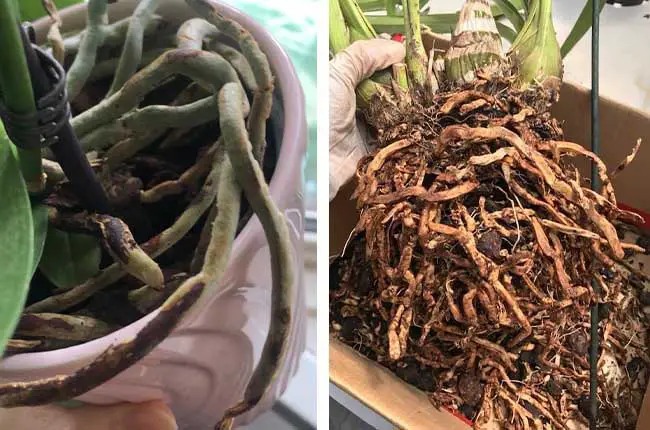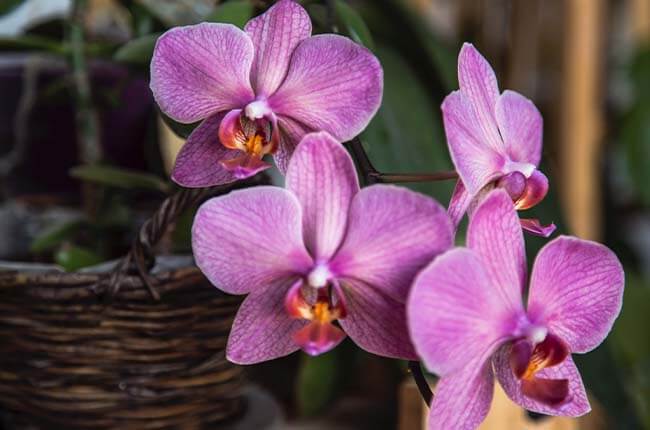When it comes to orchid care, the attention is often on watering. Fertilizing is often ignored. If you have just been watering your orchid without properly fertilizing it, you are just giving it water and not enough food.
However, orchids that are potted and grown as houseplants depend on us to feed them food. They are removed from their natural habitat in the rainforest and cannot receive their nutrients from animal droppings or decomposing plant matters brought to them by the rain.
Well-fertilized orchids do not have problems with nutrient deficiency and thus have noticeably better root formation, multiple flower spikes, and increased resistance against pests and diseases.
So, what kind of nutrients do orchids need?
Orchids need to be fed a low concentration of fertilizer frequently. The best orchid fertilizer should be nitrate-based, complete with macronutrients and micronutrients. The fertilization routine should adjust, according to the growth, blooming and dormant phases and also the orchid species.
In this article, we will look at what nutrients orchids need, how to choose the best fertilizers, and how to fertilize orchids correctly without fertilizer burn.
For recommendations on the best orchid fertilizer, we have dedicated a separate article on a comprehensive review on the 10 most popular fertilizers in the market.
1. What makes a good orchid fertilizer?
The nutrients that epiphytic orchids need are very different from plants grown in soil in terms of the concentration and the nutrient profile.
Orchids are used to absorb low concentration of nutrients in each feeding because they are adapted to not always having food in the rainforest. In their natural habitat, they only get their food when there are dead leaves, animal droppings or other organic materials washed down in their proximity.
To mimic their natural way of getting nutrients, the recommendation for fertilizing orchids is to feed weekly, weakly around the year, meaning it is better to feed more often using a low concentration (such as one-fourth of the recommended strength) of fertilizer than feeding less often using a high concentration. If fed a high concentration of fertilizers, the orchid roots will burn.
In terms of the types of nutrients, orchids need both macronutrients (Nitrogen, phosphorous and potassium) which are needed in large quantities, and micronutrients (e.g. zinc, manganese, iron, copper, boron and molybdenum) which are needed in trace amounts.
Their nitrogen needs must be in the form of a non-urea, or nitrate-based, fertilizer. This is because soil organisms must first convert the nitrogen (N) in urea into nitrate (NO3), etc. which is a form usable by orchids. Since orchids do not grow in soil, such a conversion is not possible and they can absorb nitrogen only in the form of nitrate. This is a major reason why coffee and rice water do not work as fertilizers for orchids.
For these two reasons, orchid growers should only use fertilizers specifically created for orchids instead of using all-purpose fertilizers for plants.
2. Importance of macro and micronutrients for orchids
Both macronutrients and micronutrients are important for orchid growth. Each of them plays a role that helps in one way or another in photosynthesis, growth development by building cell walls. Deficiency in any of the nutrients would result in chlorosis, yellowing of leaves, stunt growth, dieback of new growths and even death of a plant.
This is a great article to learn more about nutrient deficiency in orchids.
The nutrients that are needed in the highest quantities are: Nitrogen (N), Potassium (P) and Potassium (K).
Micronutrients are equally important in a complete, balanced orchid diet. They are essential parts of the plant’s enzyme systems and play important roles in photosynthesis such as nitrogen fixation, protein synthesis.
The table below shows some of the essential nutrients and their functions.
| Nutrient | Function |
| Nitrogen (N) | Fuels leaf production |
| Phosphorous (P) | Improves root growth and flowering |
| Potassium (K) | Supports overall growth |
| Calcium (Ca) | Builds cell walls in new growths |
| Magnesium (Mg) | Essential building block for chlorophyll. If there is not enough Magnesium, the plant will take it from the older leaves that will then yellow. |
| Iron (Fe) | Essential for vital plant functions such as the production of enzymes and chlorophyll, nitrogen fixing, development and metabolism. |
| Copper (Cu) | Activates plant enzymes, participates in photosynthesis, assists in plant metabolism |
| Molybdenum (Mo) | Helps to transform nitrates into protein for plant growth. Deficiency in Molybdenum would stunt plant growth, resulting in leaves with pale green or yellowish green in color. |
| Manganese (Mn) | Essential for photosynthesis, respiration, and nitrogen assimilation |
| Zinc (Zn) | Cell growth, wound healing |
| Boron (B) | Cell division, seed formation |
3. How to fertilize orchids
For optimal orchid growth, one should pay attention to a few things:
- You can fertilize the roots with fertilizer with macronutrients and spray the leaves with fertilizer with micronutrients. Here is an article with details about foliar feeding orchids.
- Orchid growers generally take the “weakly, weekly” approach to fertilizing orchids. The specific concentration and the feeding frequency can vary, depending on the orchid’s growth phase, the type of the orchid, the age of the orchid, the type of water used, the type of growing medium, etc. For example, orchids in the blooming stage require the highest amount of nutrients, compared to their growth phase and dormancy stage; Vandas are heavy feeders and need a copious amount of nutrients.
- In general, the recommended dose is ½ or ¼ teaspoon of fertilizer diluted in 1 gallon of water. The frequency can be once every two weeks, once every week or twice a week. When in doubt, it is better to start with a weaker fertilizer solution for several months.
- It is also best to use rainwater, filtered water or reverse-osmosis water.
- Adjust the concentration and frequency according to the growth phase. Orchids require more nutrients during the active growth phase, less during periods of slower growth and dormancy.
- Water the medium with plain water first before watering again with a fertilizer solution. This is to prevent root burn due to fertilizer and also prevent salt buildup.
4. Fertilizer burn and treatment
An inappropriate concentration or mix of minerals would stunt root growth, or even kill the plant in the worst case.
Watch for signs of salt crust on the surface of the potting medium, brown root tips, brown roots. At a later stage, leaf tips would become brown, indicating root burn. Here is an article on how to properly feed your orchids. Leaves can also become yellow. If no measure is taken, it would kill the plant.

Treatment:
If you notice early signs of fertilizer burn, flush the medium with soft water and lower the concentration and frequency of fertilizing.
For serious cases, remove the orchid from the pot and its medium. Flush the roots under the tap to remove any mineral buildup. Remove any rotten roots and parts. Repot in a new medium and new pot away from direct light.
Fertilize only when the orchid has recovered and resumed growing.
Conclusion
To sum up, a good orchid fertilizer should contain nitrogen in the form of nitrate, and not ammonia or urea, complete with macronutrients and micronutrients.
The fertilizing routine should be adjusted accordingly when they are in the growth, blooming or dormant stage and even according to the orchid species. The “feed weekly, weakly” approach should be applied at all times when feeding orchids to avoid fertilizer burn.
Happy growing!
Related
Top 10 Orchid Fertilizers: A Detailed Review (2021)
Why You Should Foliar Feed Orchids (& How To Do It Right)
Sources
American Orchid Society: How Do I Feed My Orchid?
American Orchid Society: Fertilizer Burn
Wang, Y. T. (1996). Effects of six fertilizers on vegetative growth and flowering of Phalaenopsis orchids. Sci. Hortic., 65:191-197.
- Keiki Paste vs Rooting Hormone:What’s the difference? - February 4, 2024
- Top 10 Orchid Fertilizers: A Comprehensive Review (2024) - February 2, 2024
- Top 8 Soil Inoculants For Stronger Plants (2024) - February 1, 2024


